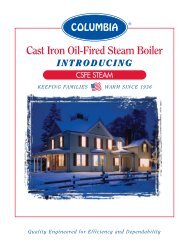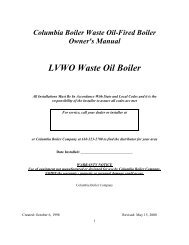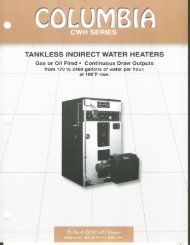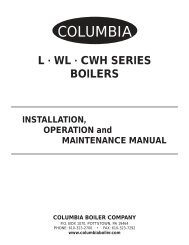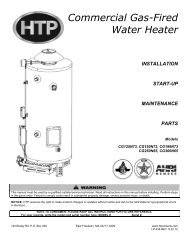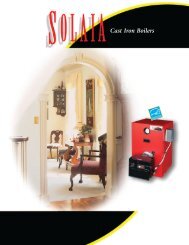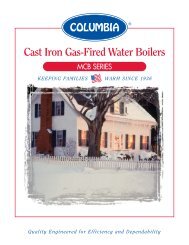Sizing Cast Iron Radiator Heating Capacity Guide - Columbia Heating
Sizing Cast Iron Radiator Heating Capacity Guide - Columbia Heating
Sizing Cast Iron Radiator Heating Capacity Guide - Columbia Heating
Create successful ePaper yourself
Turn your PDF publications into a flip-book with our unique Google optimized e-Paper software.
<strong>Columbia</strong> <strong>Heating</strong> Products Company1409 Rome RdBaltimore, Maryland 21227410-242-5300Toll Free 800-645-7845www.columbiaheating.com<strong>Cast</strong> <strong>Iron</strong> <strong>Radiator</strong> <strong>Heating</strong> <strong>Capacity</strong> <strong>Guide</strong>Use this handy guide to determine how much heat existing "old style" radiators giveoff or how much heat a boiler must supply to them.- IntroductionMany types of radiators are now used to heat the rooms of homes and buildingswhich have central steam or hot water boiler systems but for the first half of this centurycast iron radiators were the overwhelming favorite form of radiation. Although there arenow very few manufacturers, cast iron radiation is still one of the most comfortable, quietand durable ways to heat a room. <strong>Cast</strong> iron radiators heat up slowly and cool downslowly to give a very gentle, even, radiant heating. Since the 50's less expensive copperfinned convectors and baseboard have come to predominate but the heating is harshermore of an "all on," "all off" effect.Technical ExplanationThe Heat Output of any radiator is determined by:1. Temperature of the surrounding air which is usually assumed to be 70 degrees2. Temperature of the radiator's surface which is directly related to the temperatureof the water or steam inside the radiator. Naturally, the hotter the radiator themore heat it will radiate.3. Surface area of the radiator. Naturally, the larger the radiator the more heat it canradiate.
The TOTAL of the Square feet EDR ratings of all the radiators in a house multiplied byeither:• 170 BTUs per hour if its a hot water based system or• 240 BTUs per hour if its a steam systemis how much heat the boiler in the house must deliver to make all of those radiators hot.Usually that's more than enough heat to keep the house warm - even on the coldest day -and even enough to dry everyone's wet mittens at the same time!In fact, when they were built most houses with cast iron radiators weren't very wellinsulated and often didn't have storm windows. Since then many have had energy savingimprovements so the total radiator heating capacity is now much greater than theminimum needed according to the building's actual heat loss. It is, however, verycomforting to really "cook" all those radiators on bitter cold days.Replacement steam boilers must have enough power to fill every radiator withsteam but replacement hot water boilers for the improved home can be selected accordingto the actual heat loss instead of radiator heating capacity if the residents can accept thelower water and radiator temperature which will result.This all sounds pretty simple, huh? Well it is, the only trick is determining the EDRsquare footage for each radiator.<strong>Cast</strong> <strong>Iron</strong> <strong>Radiator</strong> <strong>Heating</strong> <strong>Capacity</strong> <strong>Guide</strong>- Looking at a <strong>Radiator</strong>There are three general classifications of radiators found in older homes: ColumnType, Tube Type and Wall Type. More recently cast iron 9" tall baseboard has beenavailable. First, this guide will demonstrate how to identify and find the EDR ratings forfloor standing column and tube type radiators which are what most of us think of firstwhen we think of "radiators". Wall type radiators will be discussed afterwards.Column TypeTube Type
Wall TypeA traditional cast iron column or tube type radiator is described and measured in termsof:1. HEIGHT in inches2. Number of SECTIONS As you stand in front of a radiator it almost looks like aloaf of bread. Each cast iron slice is called a section.3. Number of TUBES or COLUMNS. As you look at a radiator from the narrow endyou can tell that each of the above slices or sections is made up of 1 or morevertical columns or tubes. The real old ones are about 2 1/2" wide and they arecalled COLUMNS. In "newer" radiators these vertical cast iron pipes are onlyabout 1 1/2" wide and are called TUBESRight! We really don't care about a floor standing radiator's overall width or depth. So goahead. Jot down the number of tubes and sections and the height of every radiator.5 Tubes, 7 Sections 2 Columns, 7 SectionsCheck the next page's table to get the Square feet EDR of one section of eachradiator. Then multiply that by the number of sections in the radiator and you'll have theSquare Foot EDR rating of that radiator. Multiply that total by either 170 Btus per hour(hot water systems) or 240 BTU’s per hour (steam systems) to get the design heatingcapacity of that one radiator. Do the same for all the radiators in that system. The sum ofall these heating capacities is a home's total radiation heating demand on its boiler.<strong>Cast</strong> <strong>Iron</strong> <strong>Radiator</strong> <strong>Heating</strong> <strong>Capacity</strong> <strong>Guide</strong>- EDR Ratings and Square Feet Per SectionsColumn or Tube Type <strong>Radiator</strong> EDR Chart (# of tubes/height)
13" 16" 18" 20" 22" 23" 26" 30" 32" 36" 38" 45"3 Tubes 1.72 2.00 2.33 3.00 3.50 3.504 Tubes 2.25 2.50 2.75 3.50 4.255 Tubes 2.67 3.00 3.50 4.33 4.33 5.00 6.006 Tubes 3.00 3.50 4.00 5.007 Tubes 2.60 3.50 4.20 4.751 Column 1.50 1.67 2.00 2.50 3.002 Cols. 2.00 2.33 2.67 3.33 4.00 5.003 Cols. 2.25 3.00 3.75 4.50 5.00 6.004 Cols. 3.00 4.00 5.00 6.50 8.00 10.05 Cols. 3.00 3.75 4.50 5.00 6.30 7.00 8.50 10.01. Find the Sq. Ft. EDR per section above2. Multiply by the number of sections altogether in that radiator to get Sq. Ft. EDRfor the entire radiator3. Multiply by 240 BTUs per hour to get the steam design outputor Multiple by 170 BTUs per hour to get the hot water design outputForgot how to identify & measure radiators?Wall <strong>Radiator</strong> EDR RatingsAll wall radiator may be composed of one or more flat wall hung sections. Eachsection can be best identified by measuring in inches its height, its width and its depth orthickness. Jot down those measurements then use the following chart to find the Squarefeet EDR of the section closest to those dimensions.Height Width Thickness EDR13" 15 5/8" 2 7/8" 513" 21 7/8" 2 7/8" 722" 13 3/16" 3 1/16" 718" 29 1/16" 2 7/8" 929" 18 5/16" 3 11/16" 9Wall <strong>Radiator</strong>1. Find the Sq Ft EDR per section above2. Multiply by the number of sections altogether in that radiator to get Sq. Ft. EDRfor the entire radiator3. Multiply by 240 BTUs per hour to get the steam design outputor Multiple by 165 BTUs per hour to get the hot water design output



